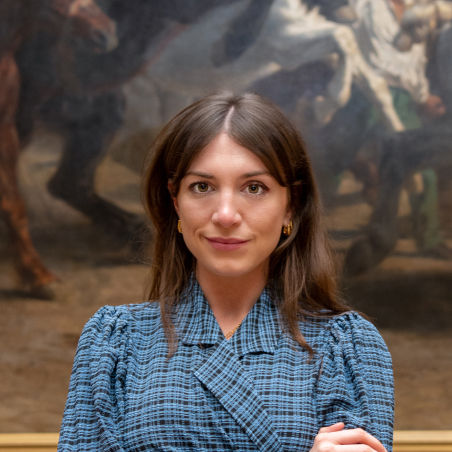Katy Hessel visits one of her favorite works in The Met, painted in 19th-century Paris, when the Academy’s rigid hierarchies reigned supreme.
At the time, paintings of the human figure were considered the most prestigious genre of artmaking—but women were barred from the life room, where they could paint from observation of live models. Rosa Bonheur was not deterred. Turning to images readily available to her, she painted The Horse Fair (1852–55), a monumental depiction of a horse market.
Listen to the conversation, or read the full transcript below.
Transcript
KATY HESSEL (Voiceover): The Horse Fair by Rosa Bonheur is a massive painting which features a group of horses at a market in unbelievable detail. When I visited this painting in person, I was completely in awe.

Rosa Bonheur (French, 1822–1899). The Horse Fair, 1852–55. Oil on canvas, 8 ft. 1/4 in x 192 ft. 7 1/2 in. (244.5 x 506.7 cm). The Metropolitan Museum of Art, New York, Gift of Cornelius Vanderbilt, 1887 (87.25)
HESSEL: Oh… there it is. I think this work is just absolutely extraordinary.
What’s incredible about this painting is the fact that, well first of all it was the largest ever painting dedicated to animals in the 1850s when it was made. Women were restricted in what they could do. They were not admitted legally to the life room where they could study the nude from life. And this was the ultimate skill as an artist to be able to understand the body. But because women were prohibited from that, they had to look at other genres. And so that’s why we see so many artists investigating still life and landscape. But Rosa Bonheur really pioneered animal painting.
And actually she was so obsessed with animals when she was younger—she would go to the butchers and study the carcasses of all these animals.
And here, I mean she was so dedicated, she used to go to this horse fair on a biweekly basis.
And so the fact that she did this was so groundbreaking. And also she said, okay, well if you are going to restrict me to this type of genre, then not only am I going to make it on the scale of Grand Masters, not only am I going to combine and culminate all these different aspects, but I’m also going to dedicate it to this subject that’s also been overlooked and give equal precedence to animals and humans.
HESSEL (Voiceover): Listen on to hear more incredible stories about women artists at The Met.
###
This audio tour is one in a series of tours called Museums Without Men produced by Katy Hessel in collaboration with institutions across the globe, such as the Fine Arts Museum San Francisco, the Hepworth Wakefield, the Hirshhorn Museum and Sculpture Garden, and Tate Britain. The series encourages museum visitors to seek out work by great women and gender non-conforming artists in these institutions who, simply by virtue of their gender, were often overlooked and underrepresented.





















